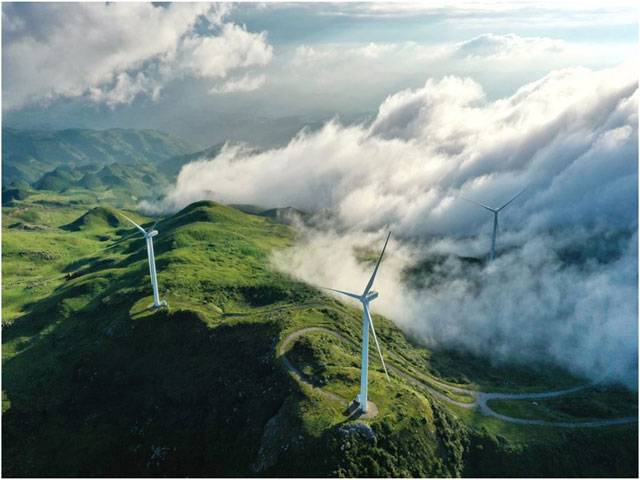GUIYANG - China is the world’s largest producer and consumer of energy, with fossil fuels making up about 85 per cent of the energy structure.
China has vowed to attain carbon dioxide emissions peak before 2030 and achieve carbon neutrality before 2060. The country is going full throttle to develop new energy resources and increase their proportion in primary energy consumption nationwide, which are expected to lighten the burden on the environment and ecosystems and provide practical solutions to mitigating soil, surface water and air pollutions, said Lei Yizhu, head of Guizhou’s carbon neutrality research institute.
“Such efforts can also greatly promote China’s carbon dioxide emission reduction, slowing down global warming and improving the global climate conditions,” Lei said.
During the 14th Five-Year Plan period (2021-2025), as the country strives for low-carbon transition, relevant eco-friendly industries in fields such as clean energy are to cash in the bonanza, said Zhao Weidong, head of the institute of energy conservation and environmental protection affiliated with the Center for Information and Industry Development, under China’s Ministry of Industry and Information Technology.
“Guizhou is a newcomer in developing new energy resources as it has to grapple with mountainous terrains, low wind speeds and rainy weather,” said Shi Shaogui, director of the new energy and renewable energy department of the provincial energy bureau.
A decade ago, Guizhou had no installed power capacity of wind and photovoltaic energy. In 2011, however, the mountainous province pooled over 800 million yuan (about 124 million U.S. dollars) to build its first wind power plant in Jiucaiping. When colossal wind turbines arrived, Li Xu, a local resident in Hongxing Village, Hezhang County, was startled. He witnessed the difficult transport of hulky wind turbines up to the high mountain.
The development of new energy has since quickened in Guizhou, said Shi. By the end of 2020, the province had installed more than 5.8 million kilowatts of wind power capacity. Guizhou’s first photovoltaic power station started operation in 2015, and by the end of 2020, the province’s installed photovoltaic power capacity had exceeded 10.57 million kilowatts.
The Xianshuiwo photovoltaic power plant in Yina Township of Bijie City, Guizhou, is built at an elevation of around 2,200 meters. The power plant with rows of solar panels glittering in the sun has helped the local households make good use of their wastelands and photovoltaic resources. It is estimated that the power plant will generate around 504 million kWh of electricity with an average of 1,231 hours of solar power utilization in 2021. At the Wujiangyuan wind power plant, 198 generator units rotate in the wind. “Though wind farms are demanding in their locations, they can bring huge economic and social benefits to the local residents. The wind power plants are conducive to adjusting the regional energy structure and cutting carbon and harmful gas emission,” said Xu Chaohua, vice general manager of Guizhou clean energy branch under China Huaneng Group.
The Wujiangyuan wind farm has generated over 4.2 billion kWh of power since it started operation, which is equivalent to saving 1.33 million tonnes of standard coal. A total of 3.65 million tonnes of carbon dioxide and 119,900 tonnes of sulfur dioxide have been slashed annually thanks to the wind turbines.
By the end of 2020, more than 40 per cent of China’s installed power generation capacity came from renewable resources, supporting nearly one third of the country’s electricity consumption, data from the National Energy Administration showed.
As a result, 15.9 per cent of China’s primary energy consumption came from non-fossil energy, surpassing a target of 15 per cent set for 2020.
In 2018, the National Energy Administration launched a three-year action plan to improve the utilization rate of renewable energy in power generation. Last year, the average utilization rate of wind power and photovoltaic power reached 97 per cent and 98 per cent, respectively.
Nevertheless, China’s goal of achieving carbon neutrality by 2060 is not an easy battle.
Gao Jinshan, vice president of Goldwind, a leading renewable energy company located in northwest China’s Xinjiang Uygur Autonomous Region, assessed the existing gap between China’s current energy structure and its promise of carbon neutrality at the forum.
By the end of last year, the country’s overall installed capacity of wind power and photovoltaic power generation came in at 280 million kilowatts and about 260 million kilowatts, respectively.
To bridge the gap, China has stepped up its green transition and made comprehensive plans.
Guizhou plans to slash 40.55 million tonnes of carbon dioxide emissions annually by 2025 and reduce a whopping 71.56 million tonnes of carbon dioxide emissions annually by 2030 through the use of new energy.
Moreover, the province’s overall output of shale gas and coal bed gas is expected to surpass 100 million cubic meters in 2021, while 10 more garbage power plants will be built this year.
Thursday, April 18, 2024
China goes full throttle on green energy transition to achieve carbon neutrality
| Guizhou to slash 40.55m tonnes of carbon dioxide emissions annually by 2025

Stefanos Tsitsipas advances in Barcelona
4:19 PM | April 18, 2024
Met Office predicts more rains across country till April 29
2:51 PM | April 18, 2024
Punjab changes school timings for summer season
1:55 PM | April 18, 2024
Enemies of Pakistan are unable to digest investment in the country: Ataullah Tarar
1:29 PM | April 18, 2024
IHC restores Bushra Bibi's appeal for shifting to Adiala Jail from Bani Gala
1:24 PM | April 18, 2024
Hepatitis Challenge
April 18, 2024
IMF Predictions
April 18, 2024
Wheat War
April 18, 2024
Rail Revival
April 17, 2024
Addressing Climate Change
April 17, 2024
Justice denied
April 18, 2024
AI dilemmas unveiled
April 18, 2024
Tax tangle
April 18, 2024
Workforce inequality
April 17, 2024
New partnerships
April 17, 2024
ePaper - Nawaiwaqt
Advertisement
Nawaiwaqt Group | Copyright © 2024





